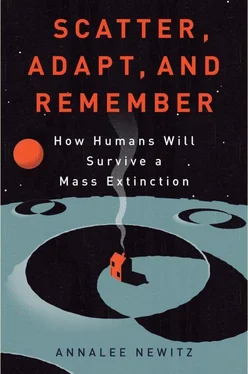2. “We are seeing a mechanism that changed”: Young said this through a press release from Ohio State University about his NSF-funded research. See Pam Frost Gorder, “Appalachian Mountains, Carbon Dioxide Caused Long-Ago Global Cooling,” Ohio State University Research News (October 25, 2006).
3. Adrian Melott, a professor of physics and astronomy at the University of Kansas: Personal interview, September 27, 2011. For more information on the gamma-ray theory and the 63-million-year cycle, you can read A. Melotte et al., “Did a Gamma-Ray Burst Initiate the Late Ordovician Mass Extinction?” International Journal of Astrobiology 3 (2004): 55, and Robert A. Rohde and Richard A. Muller, “Cycles in Fossil Diversity,” Nature 434 (March 10, 2005): 208–10.
4. Donald Canfield conducted a study of the atmosphere: Donald E. Canfield, et al., “Devonian Rise in Atmospheric Oxygen Correlated to the Radiations of Terrestrial Plants and Large Predatory Fish,” Proceedings of the National Academy of Science 107 (October 19, 2010): 17911–15.
5. Alycia Stigall, has a theory that could explain: Personal interview, September 22, 2011. See also Alycia Stigall, “Invasive Species and Biodiversity Crises: Testing the Link in the Late Devonian,” PLoS One 5(12) (2010): e15584.
CHAPTER THREE: THE GREAT DYING
1. Paul Renne, the center’s head geologist: Personal interview, October 4, 2011. See also Paul Renne et al., “Synchrony and Causal Relations Between Permian-Triassic Boundary Crises and Siberian Flood Volcanism,” Science 269 (September 8, 1995): 1413–16.
2. Jonathan Payne, a geologist at Stanford: Personal interview, November 7, 2011. See also Payne and his colleagues’ paper on this topic: Jonathan L. Payne et al., “Calcium Isotope Constraints on the End-Permian Mass Extinction,” PNAS 107 (May 11, 2010): 8543–48.
3. The Permian expert Mike Benton: For a terrific account of what happened during the Permian mass extinction, see Michael J. Benton, When Life Nearly Died: The Greatest Mass Extinction of All Time (London: Thames & Hudson, 2003).
4. For answers, I visited Peter Roopnarine, a zoologist: Personal interview, November 21, 2011. See also P. D. Roopnarine, “Ecological Modeling of Paleocommunity Food Webs,” in G. Dietl and K. Flessa, eds., Conservation Paleobiology , The Paleontological Society Papers 15 (2009).
CHAPTER FOUR: WHAT REALLY HAPPENED TO THE DINOSAURS
1. “It is very hard to imagine what happened”: Personal interview, February 1, 2012. For more about what might have happened directly after the bolide impact, see Jan Smit et al., “The Aftermath of the Cretaceous-Paleogene Bolide Impact,” Geophysical Research Abstracts 13 (2011): 12724. And for Smit and his colleagues’ original groundbreaking paper about the bolide impact, see Jan Smit et al., “An Extraterrestrial Event at the Cretaceous-Tertiary Boundary,” Nature 285 (May 22, 1980).
2. Cretaceous-Tertiary (K-T) mass extinction: Though most mass extinctions are usually referred to using the geological periods they ended (such as the Permian mass extinction, or the Ordovician mass extinction), the K-T mass extinction is known by a name that refers to two geological periods, the Cretaceous (which follows the Jurassic) and the Tertiary. These are two names for roughly the same period of geological time, which was ended by a mass extinction. Welcome to the weirdness of geological nomenclature, which is a confusing mix of older and newer names, some of which refer to overlapping stretches of time. Making things even more complex are the many names for geological periods used in Asia and other regions of the world. Some paleontologists prefer to call this extinction the Cretaceous-Paleogene (K-P) mass extinction, because the Paleogene is the period that comes after the Cretaceous. However, you’re more likely to hear the mass extinction called K-T, so I’ve chosen to call it that here.
3. “iridium anomaly”: See the Alvarezes’ first paper on this subject here: L. W. Alvarez, W. Alvarez, F. Asaro, and H. V. Michel, “Extraterrestrial Cause for the Cretaceous-Tertiary Extinction,” Science 208 (1980): 1095–1108.
4. Princeton geologist Gerta Keller began publishing papers: Personal interview, September 23, 2011. See also her papers about the discoveries she made in India: G. Keller et al., “Deccan Volcanism Linked to the Cretaceous-Tertiary Boundary Mass Extinction: New Evidence from ONGC Wells in the Krishna-Godavari Basin,” Journal of the Geological Society of India 78 (2011): 399–428; and G. Keller et al., “Environmental Effects of Deccan Volcanism Across the Cretaceous–Tertiary Transition in Meghalaya, India,” Earth and Planetary Science Letters 310 (October 2011): 272–85.
5. UC Berkeley paleontologist Charles Marshall said: Personal interview, October 18, 2011. Marshall made this comment after I asked him what he thought of Keller’s theories.
6. Smit told the BBC: This comment comes from an interview Smit did with the BBC program Horizon, in the episode “What Really Killed the Dinosaurs?” You can read a transcript here: http://www.bbc.co.uk/sn/tvradio/programmes/horizon/dino_trans.shtml.
7. the dinosaurs died of fungal infections: See Arturo Casadevall, “Fungal Virulence, Vertebrate Endothermy, and Dinosaur Extinction: Is There a Connection?” Fungal Genetics and Biology 42 (2005): 98–106.
8. Brown University geologist Jessica Whiteside put it: Personal interview, January 12, 2012. See also: J. H. Whiteside, P. E. Olsen, D. V. Kent, S. J. Fowell, and M. Et-Touhami, “Synchrony Between the CAMP and the Triassic-Jurassic Mass-Extinction Event? Reply to Comment of Marzoli et al,” Palaeogeography, Palaeoclimatology, and Palaeoecology 262 (2008): 194–98.
9. CAMP: A helpful map of the CAMP eruption can be found here: http://www.auburn.edu/academic/science_math/res_area/geology/camp/Fig1.jpg.
10. Jennifer McElwain, a paleobotanist at University College Dublin: Personal interview, January 16, 2012.
11. dinofuzz: See Ryan C. McKellar et al., “A Diverse Assemblage of Late Cretaceous Dinosaur and Bird Feathers from Canadian Amber,” Science 16 (2011): 1619–22.
12. they may have been social, like birds: See, for example, D. J. Varricchio, Paul C. Sereno, Zhao Xijin, Tan Lin, Jeffery A. Wilson, and Gabrielle H. Lyon, “Mud-Trapped Herd Captures Evidence of Distinctive Dinosaur Sociality,” Acta Palaeontologica Polonica 53 (2008): 567–78.
CHAPTER FIVE: IS A MASS EXTINCTION GOING ON RIGHT NOW?
1. University of Oregon archaeologist Dennis Jenkins: Personal interview, February 9, 2012. See also Dennis Jenkins et al., “Clovis Age Western Stemmed Projectile Points and Human Coprolites at the Paisley Caves,” Science 337 (2012): 223–28.
2. UC Berkeley biologist Anthony Barnosky has been at the forefront: Personal interview, October 18, 2011.
3. March 3, 2011, issue of Nature: Anthony Barnosky et al., “Has the Earth’s Sixth Mass Extinction Already Arrived?” Nature 471 (2011): 51–57.
4. Peter Ward, a geologist at the University of Washington: Personal interview, September 27, 2011. See also Peter Ward, The Medea Hypothesis: Is Life on Earth Ultimately Self-Destructive? (Princeton, NJ: Princeton University Press: 2009).
CHAPTER SIX: THE AFRICAN BOTTLENECK
1. “effective population size”: For more on this concept, see Matthew B. Hamilton’s valuable primer Population Genetics (West Sussex: Wiley Blackwell, 2009), plus you can find a good introduction to this idea in R. Kliman, B. Sheehy, and J. Schultz, “Genetic Drift and Effective Population Size,” Nature Education 1 (2008).
Читать дальше






![Аннали Ньюиц - Автономность [litres]](/books/424681/annali-nyuic-avtonomnost-litres-thumb.webp)





